Landslide Susceptibility Assessment in Active Tectonic Areas Using Machine Learning Algorithms
Abstract
:1. Introduction
2. Study Area
3. Methods and Materials
3.1. Selection of Evaluation Factors
3.2. Data Preprocessing
3.3. Selection of Machine Learning Algorithms
3.4. Parameter Preprocessing
4. Results
4.1. Collinearity Analysis of Factors
4.2. Evaluation and Optimization of Models
4.3. Landslide Susceptibility Mapping
4.4. On-Site Verification of Susceptibility Assessment Results
5. Discussion
6. Conclusions
Author Contributions
Funding
Data Availability Statement
Acknowledgments
Conflicts of Interest
References
- Petley, D. Global patterns of loss of life from landslides. Geology 2012, 40, 927–930. [Google Scholar] [CrossRef]
- Stanley, T.; Kirschbaum, D.; Zhou, Y. Spatial and temporal analysis of a global landslide catalog. Geomorphology 2015, 249, 4–15. [Google Scholar]
- Huang, R.; Fan, X. The landslide story. Nat. Geosci. 2013, 6, 325–326. [Google Scholar] [CrossRef]
- Shou, K.J.; Yang, C.M. Predictive analysis of landslide susceptibility under climate change conditions—A study on the Chingshui River Watershed of Taiwan. Eng. Geol. 2015, 192, 46–62. [Google Scholar] [CrossRef]
- Chen, M.; Tang, C.; Xiong, J.; Chang, M.; Li, N. Spatio-temporal mapping and long-term evolution of debris flow activity after a high magnitude earthquake. Catena 2024, 236, 107716. [Google Scholar] [CrossRef]
- Ayalew, L.; Yamagishi, H. The application of GIS-based logistic regression for landslide susceptibility mapping in the Kakuda-Yahiko Mountains, Central Japan. Geomorphology 2005, 65, 15–31. [Google Scholar] [CrossRef]
- Dai, J.; Yang, J.; Yao, C.; Hu, Y.; Zhang, X.; Jiang, Q.; Zhou, C. Study on the mechanism of displacement mutation for jointed rock slopes during blasting excavation. Int. J. Rock. Mech. Min. Sci. 2022, 150, 105032. [Google Scholar] [CrossRef]
- Peethambaran, B.; Leshchinsky, B. Application of landslide susceptibility towards urbanization suitability zonation in mountainous settings. Int. J. Disaster Risk Reduct. 2023, 97, 104061. [Google Scholar] [CrossRef]
- Goyes-Penafiel, P.; Hernandez-Rojas, H.R. Landslide susceptibility index based on the integration of logistic regression and weights of evidence: A case study in Popayan, Colombia. Eng. Geol. 2021, 280, 105958. [Google Scholar] [CrossRef]
- Süzen, M.L.; Doyuran, V. Data driven bivariate landslide susceptibility assessment using geographical information systems: A method and application to Asarsuyu catchment, Turkey. Eng. Geol. 2004, 71, 303–321. [Google Scholar] [CrossRef]
- Liu, C.; Li, W.; Wu, H.; Ping, L.; Kai, S.; Sun, W.; Wen, C. Susceptibility evaluation and mapping of China’s landslides based on multi-source data. Nat. Hazards 2013, 69, 1477–1495. [Google Scholar] [CrossRef]
- Qi, T.; Zhao, Y.; Meng, X.; Chen, G.; Dijkstra, T. AI-Based Susceptibility Analysis of Shallow Landslides Induced by Heavy Rainfall in Tianshui, China. Remote Sens. 2021, 13, 1819. [Google Scholar] [CrossRef]
- Chen, L.; Ma, P.; Yu, C.; Zheng, Y.; Zhu, Q.; Ding, Y. Landslide susceptibility assessment in multiple urban slope settings with a landslide inventory augmented by InSAR techniques. Eng. Geol. 2023, 327, 107342. [Google Scholar] [CrossRef]
- Napoli, M.D.; Carotenuto, F.; Cevasco, A.; Confuorto, P.; Martire, D.D.; Firpo, M.; Pepe, G.; Raso, E.; Calcaterra, D. Machine learning ensemble modelling as a tool to improve landslide susceptibility mapping reliability. Landslides 2020, 17, 1897–1914. [Google Scholar] [CrossRef]
- Zeng, T.; Wu, L.; Hayakawa, Y.S.; Yin, K.; Gui, L.; Jin, B.; Guo, Z.; Peduto, D. Advanced integration of ensemble learning and MT-InSAR for enhanced slow-moving landslide susceptibility zoning. Eng. Geol. 2024, 331, 107436. [Google Scholar] [CrossRef]
- Ciurleo, M.; Cascini, L.; Calvello, M. A comparison of statistical and deterministic methods for shallow landslide susceptibility zoning in clayey soils. Eng. Geol. 2017, 223, 71–81. [Google Scholar] [CrossRef]
- Zhao, Y.; Meng, X.; Qi, T.; Qing, F.; Chen, G. AI-based identification of low-frequency debris flow catchments in the Bailong River basin, China. Geomorphology 2020, 359, 107125. [Google Scholar] [CrossRef]
- Marjanović, M.; Kovačević, M.; Bajat, B.; Voženílek, V. Landslide susceptibility assessment using SVM machine learning algorithm. Eng. Geol. 2011, 123, 225–234. [Google Scholar] [CrossRef]
- Merghadi, A.; Yunus, A.P.; Dou, J.; Whiteley, J.; Pham, B.T.; Bui, D.T.; Avtar, R.; Abderrahmane, B. Machine learning methods for landslide susceptibility studies: A comparative overview of algorithm performance. Earth Sci. Rev. 2020, 207, 103225. [Google Scholar] [CrossRef]
- Meng, X.; Chen, G.; Guo, P.; Xiong, M.; Janusz, W. Research of landslides and debris flows in Bailong River Basin: Process and prospect. Mar. Geol. Quat. Geol. 2013, 33, 1–15. [Google Scholar] [CrossRef]
- Qi, T.; Meng, X.; Zhao, Y.; Su, X.; Chen, G.; Zeng, R.; Zhang, Y.; Li, Y.; Yue, D. Formation and distribution of landslides controlled by thrust-strike-slip fault zones and fluvial erosion in the Western Qinling Mountains, China. Eng. Geol. 2023, 47, 283–306. [Google Scholar] [CrossRef]
- Guo, C.; Zhang, Y.; Li, X.; Ren, S.; Yang, Z.; Wu, R.; Jin, J. Reactivation of giant Jiangdingya ancient landslide in Zhouqu County, Gansu Province, China. Landslides 2019, 17, 179–190. [Google Scholar] [CrossRef]
- Zhang, Z. Mechanism of the 2019 Yahuokou landslide reactivation in Gansu, China and its causes. Landslides 2020, 17, 1429–1440. [Google Scholar] [CrossRef]
- Chong, Y.; Chen, G.; Meng, X.; Bian, S.; Huang, F.; Lin, L.; Yue, D.; Zhang, Y.; Guo, F. Formation mechanism and quantitative risk analysis of the landslide-induced hazard chain by an integrated approach for emergency management: A case study in the Bailong River basin, China. Catena 2023, 233, 107522. [Google Scholar] [CrossRef]
- Li, H.; Zhang, Y.; Dong, S.; Zhang, J.; Wang, Q. Neotectonics of the Bailongjiang and Hanan faults: New insights into late Cenozoic deformation along the eastern margin of the Tibetan Plateau. Geol. Soc. Am. Bull. 2020, 132, 1845–1862. [Google Scholar] [CrossRef]
- Guzzetti, F.; Mondini, A.C.; Cardinali, M.; Fiorucci, F.; Santangelo, M.; Chang, K.T. Landslide inventory maps: New tools for an old problem. Earth Sci. Rev. 2012, 112, 42–66. [Google Scholar] [CrossRef]
- Qi, T. Spatial Distribution and Formation Mechanism of Landslides in the Bailong River Basin. Ph.D. Thesis, Lanzhou University, Gansu, China, 2022; pp. 34–51. [Google Scholar]
- Meentemeyer, R.K.; Moody, A. Automated mapping of conformity between topographic and geological surfaces. Comput. Geosci. 2000, 26, 815–829. [Google Scholar] [CrossRef]
- Zhang, X.; Liu, L.; Chen, X.; Gao, Y.; Xie, S.; Mi, J. GLC_FCS30: Global land-cover product with fine classification system at 30 m using time-series Landsat imagery. Earth Syst. Sci. Data 2020, 182, 2753–2776. [Google Scholar] [CrossRef]
- Dormann, C.F.; Elith, J.; Bacher, S.; Buchmann, C.; Carl, G.; Carré, G.; Marquéz, J.R.G.; Gruber, B.; Lafourcade, B.; Leitão, P.J.; et al. Collinearity: A review of methods to deal with it and a simulation study evaluating their performance. Ecography 2013, 36, 27–46. [Google Scholar] [CrossRef]
- Yilmaz, I. Landslide susceptibility mapping using frequency ratio, logistic regression, artificial neural networks and their comparison: A case study from Kat landslides (Tokat—Turkey). Comput. Geosci. 2009, 35, 1125–1138. [Google Scholar] [CrossRef]
- Xu, Y.; Ju, L.; Tong, J.; Zhou, C.M.; Yang, J.J. Machine Learning Algorithms for Predicting the Recurrence of Stage IV Colorectal Cancer After Tumor Resection. Sci. Rep. 2020, 10, 2519. [Google Scholar] [CrossRef] [PubMed]
- Zeng, J.; Zhao, Y.; Zheng, J.; Zhang, Y.; Shi, P.; Li, Y.; Chen, G.; Meng, X.; Yue, D. Early Identification of River Blockage Disasters Caused by Debris Flows in the Bailong River Basin, China. Remote Sens. 2024, 16, 1302. [Google Scholar] [CrossRef]
- Zhang, F.; Liu, G.; Chen, W.; Liang, S.; Chen, R.; Han, W. Human-induced landslide on a high cut slope: A case of repeated failures due to multi-excavation. J. Rock Mech. Geotech. Eng. 2012, 4, 367–374. [Google Scholar] [CrossRef]
- Vegani, C.; Giadrossich, F.; Buckley, P.; Conedera, M.; Pividori, M.; Salbitano, F.; Rauch, H.S.; Lovreglib, R.; Schwarz, M. Root reinforcement dynamics of European coppice woodlands and their effect on shallow landslides: A review. Earth Sci. Rev. 2017, 167, 88–102. [Google Scholar] [CrossRef]
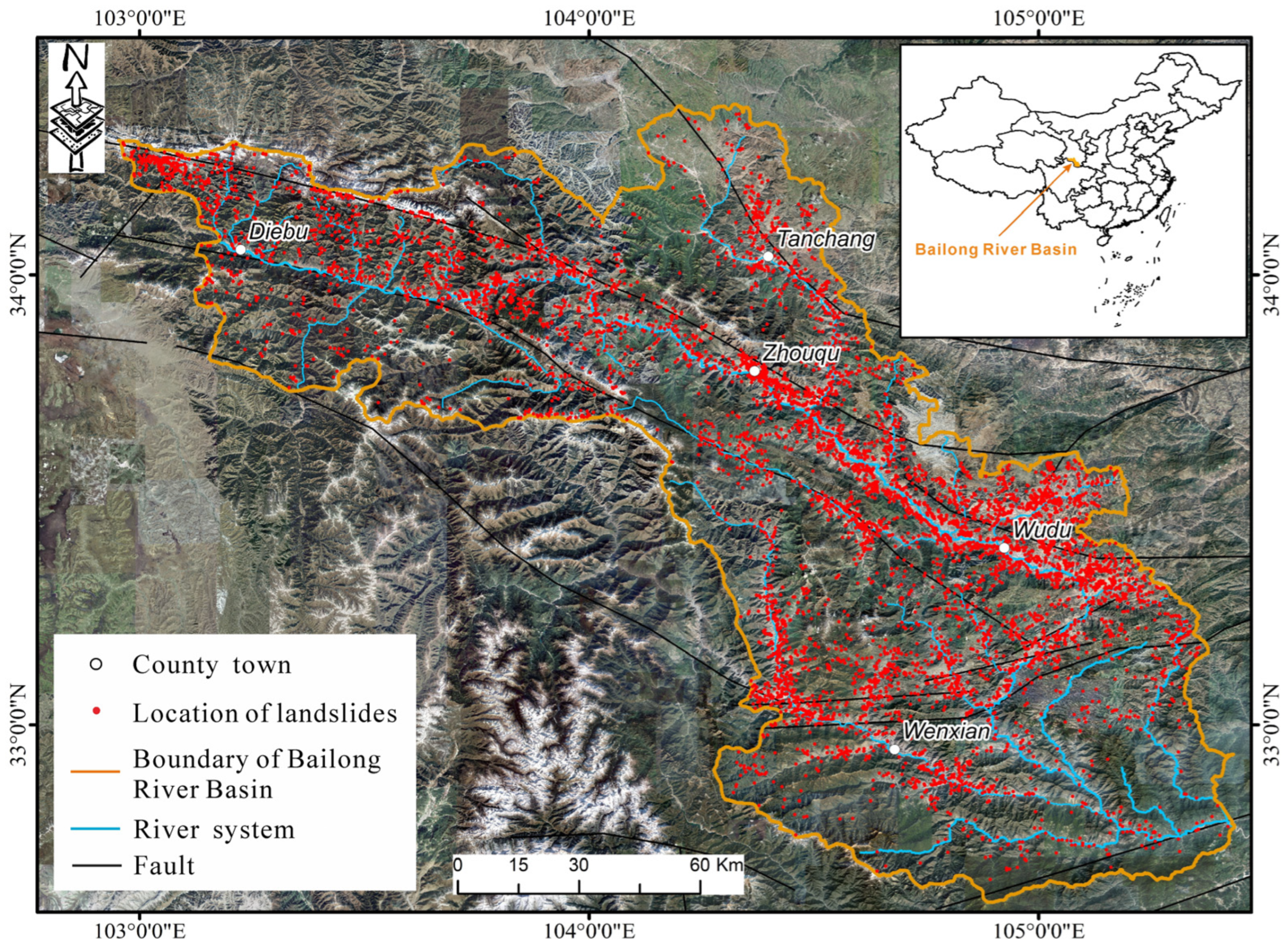
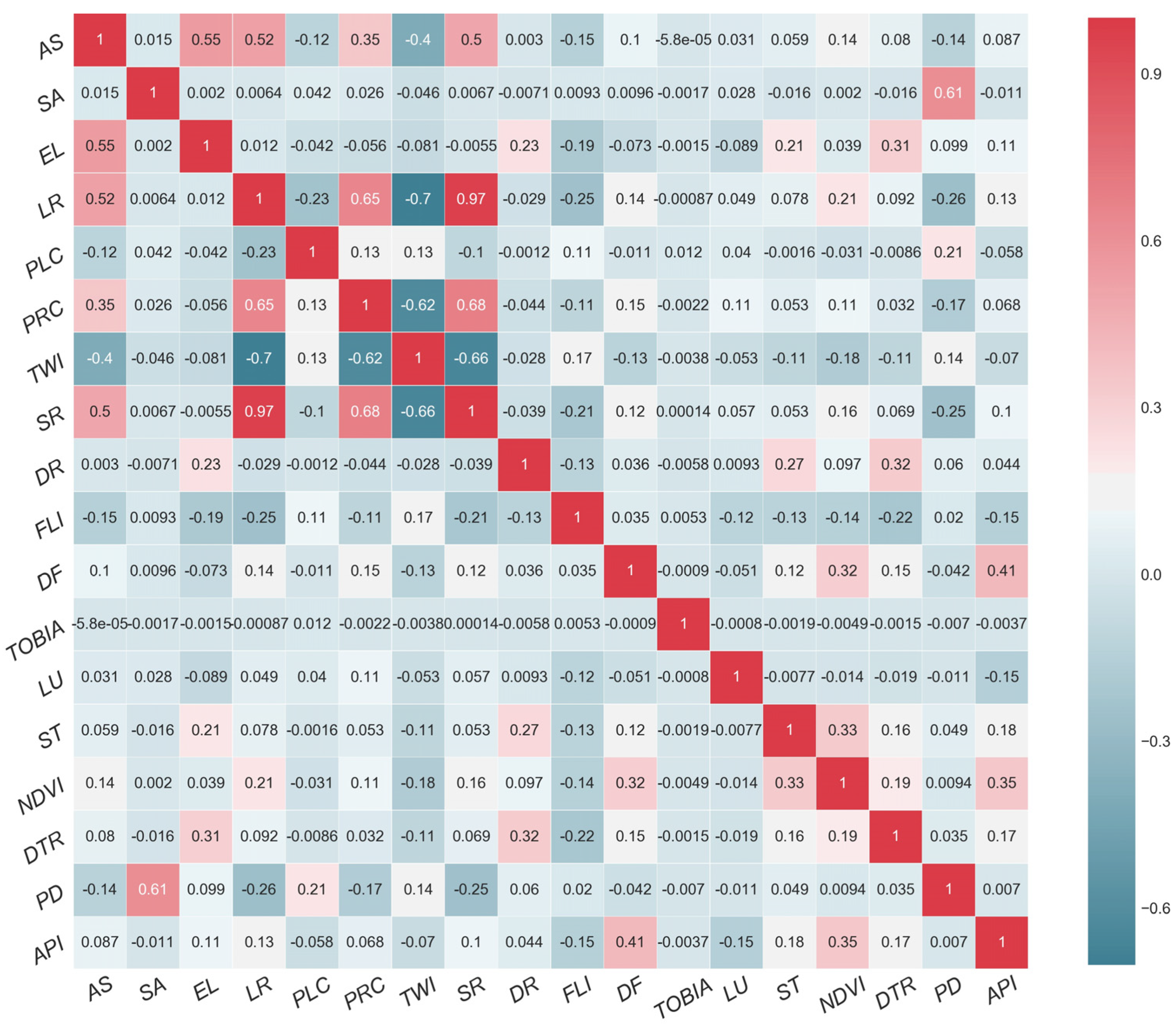

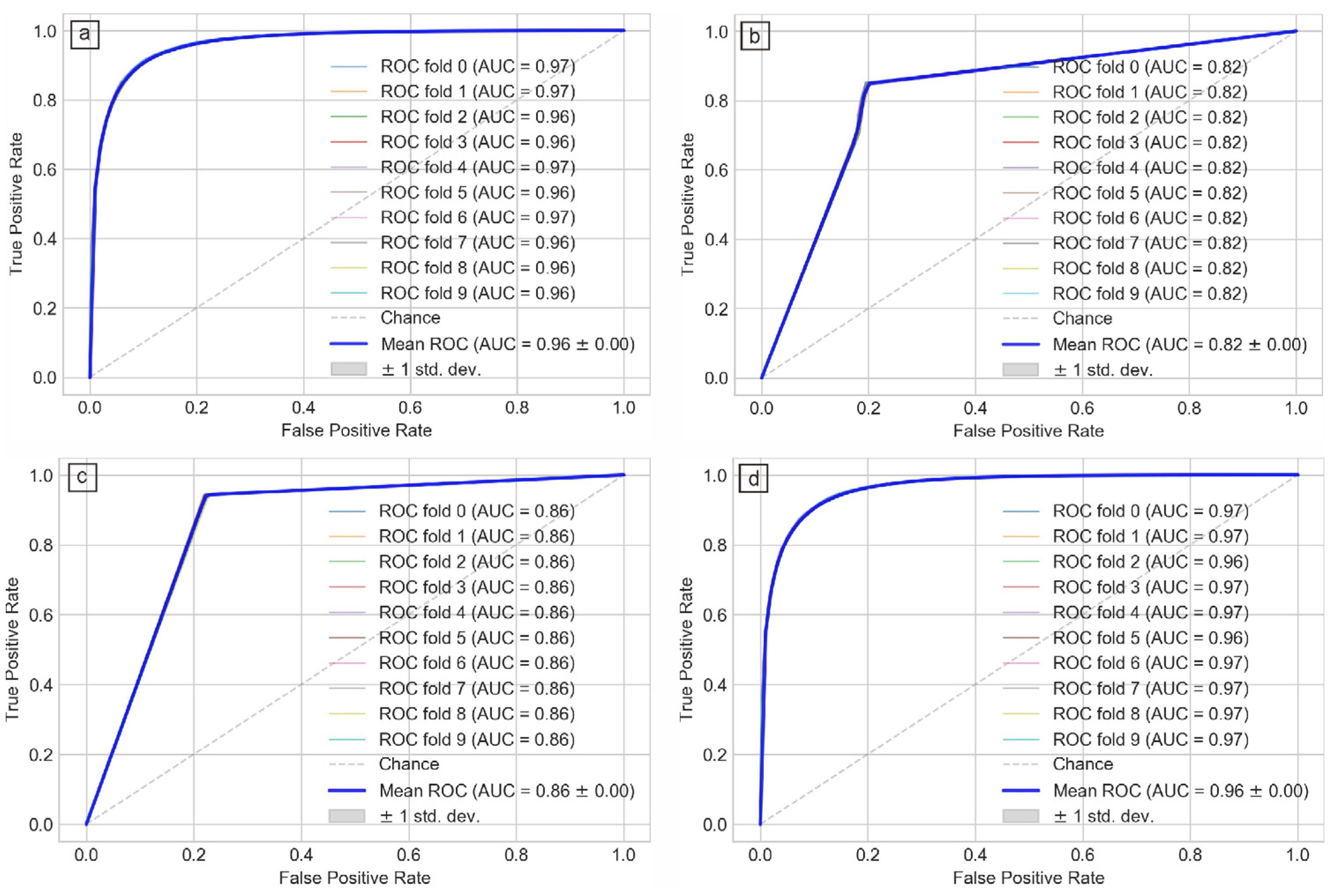

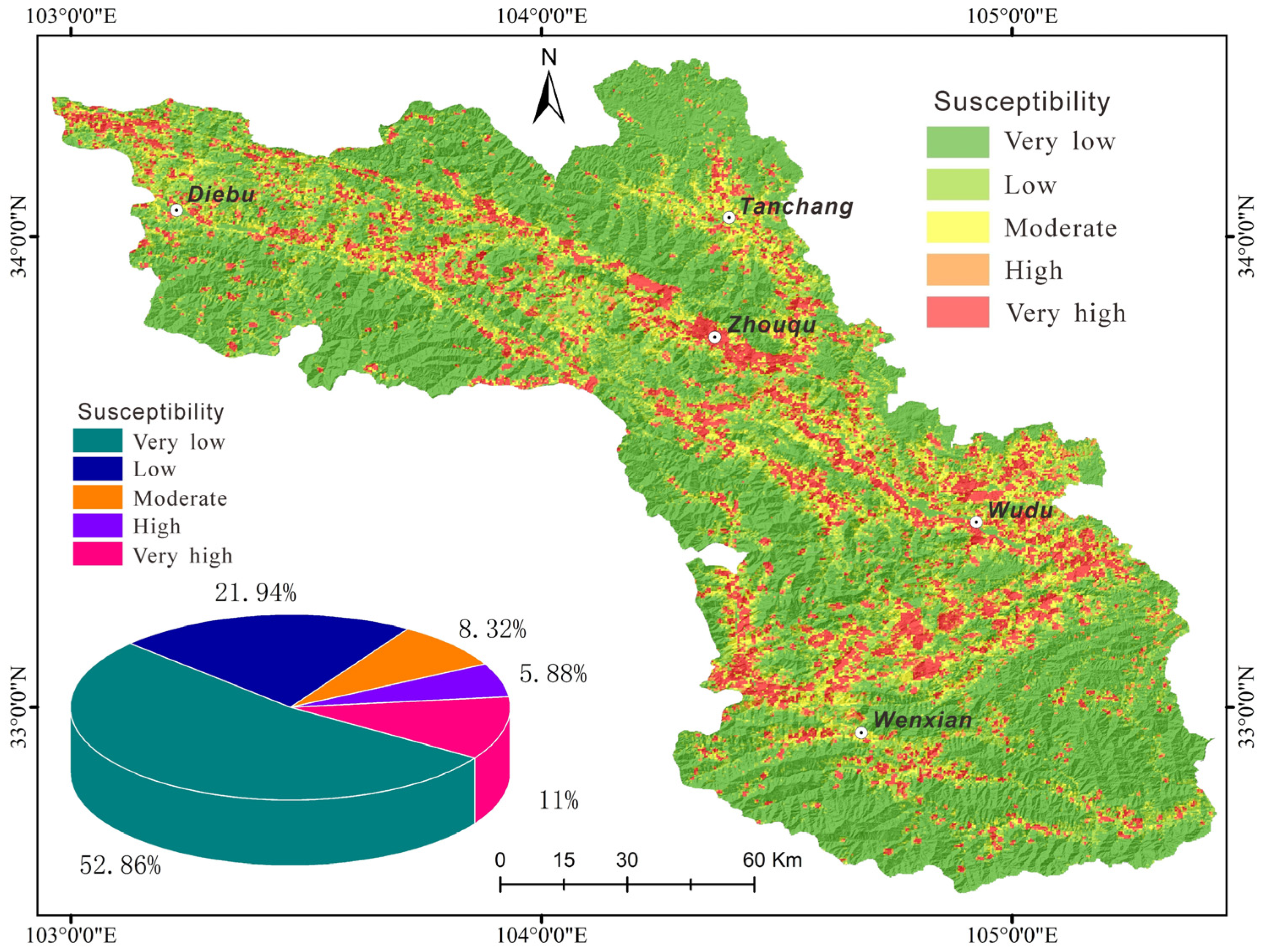
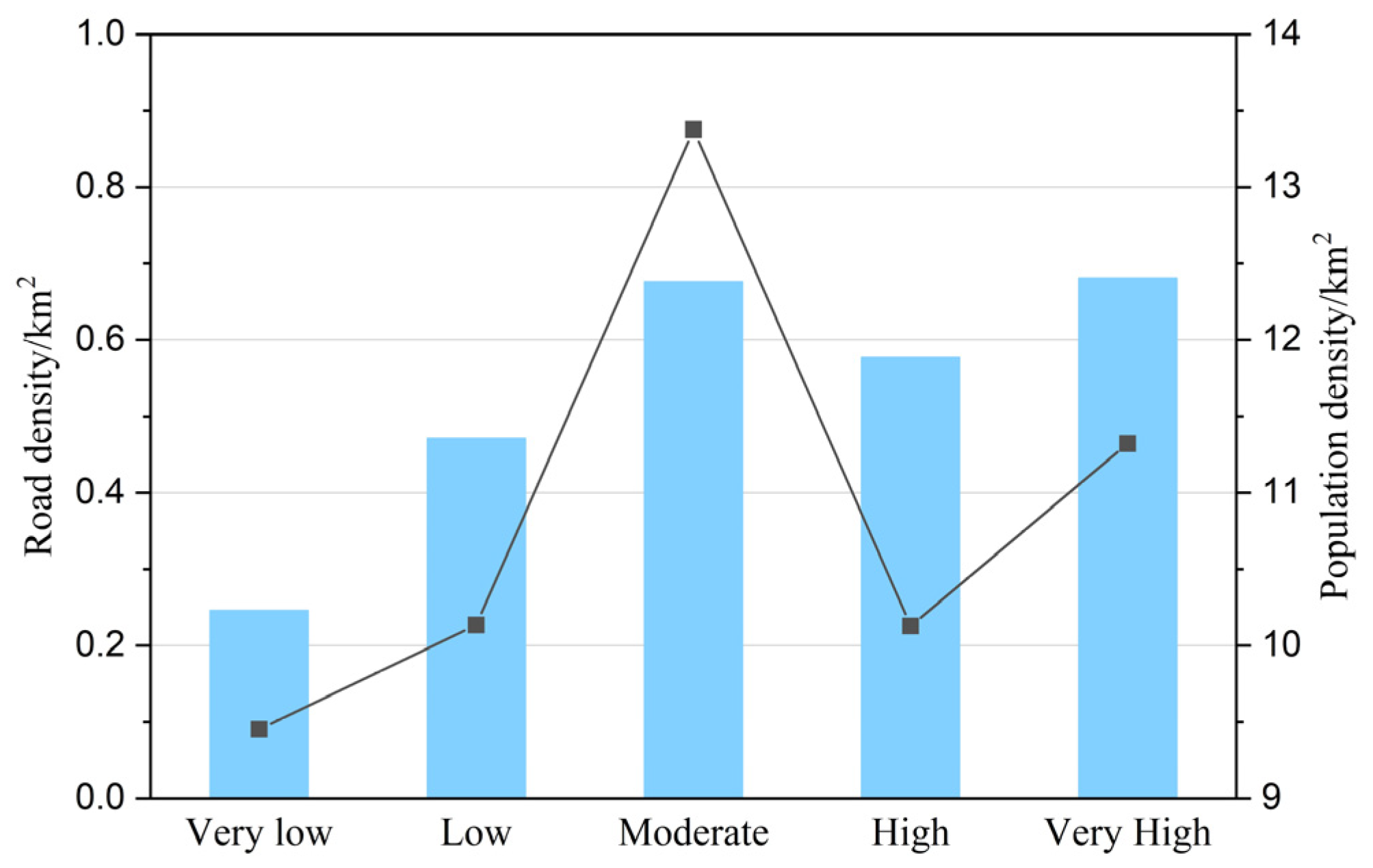



| Type | Data | Abbr. | Source | Spatial Resolution |
|---|---|---|---|---|
| Topography | Slope gradient | AS | Derived from DEM | 12.5 m |
| Slope aspect | SA | Derived from DEM | 12.5 m | |
| Elevation | EL | Derived from DEM | 12.5 m | |
| Local relief | LR | Derived from DEM | 12.5 m | |
| Planar curvature | PLC | Derived from DEM | 12.5 m | |
| Profile curvature | PRC | Derived from DEM | 12.5 m | |
| Topographic wetness index | TWI | Derived from DEM | 12.5 m | |
| Surface roughness index | SR | Derived from DEM | 12.5 m | |
| Distance to river | DR | Derived from DEM | 12.5 m | |
| Geology | Formation lithological index | FLI | Geo-map | 1:100,000 |
| Distance to fault | DF | Geo-map | 1:50,000 | |
| Topographic/bedding-plane intersection angle | TOBIA | Geo-map | 1:100,000 | |
| Material | Land use | LU | GLC_FCS30-2020 | 30 m |
| Soil type | ST | HWSD | 1 km | |
| Normalized Difference Vegetation Index | NDVI | GF-1 satellite | 8 m | |
| Human activity and inducing factors | Distance to road | DTR | Google Earth image | 1 m |
| population density | PD | 91 Weitu | 1 km2 | |
| Annual precipitation index | API | 2000–2020 | year |
| Models | Characteristic |
|---|---|
| Random Forest Classifier | Uses many classification trees to stabilize model predictions. Each decision of a tree is further based on a randomly selected predictor, and the predictions of category assignments are determined by a majority vote of all trees. The proportion of trees predicting the existence of landslides in the set can be used as an indicator of landslide susceptibility. |
| Bagging Classifier | An ensemble algorithm that establishes multiple instances estimated by black boxes on a random subset of the original training set and then, aggregates these predictions to form the final prediction. |
| K-Neighbors Classifier | For the training set, the categories of the individual instances have been determined. During the classification process, for new instances, predictions are made through majority voting based on the categories of their K nearest neighbor training instances. |
| Decision Tree | An instance-based inductive learning method that can refine a tree-like classification model from a given unordered training sample. |
| Extra Tree | A variant of Random Forest. |
| Gradient Boosting | This model applies the gradient descent technique to the regression tree. The principle is to treat the value of the basic learner (regression tree) in each iteration on x as the negative gradient of the loss function space on x, and the coefficient before the basic learner is treated as the step size to approximate the minimum value of the error function space. |
| XGBoost | Uses the boosting technique to randomly divide the initial sample set into k parts, and then divides each subset into a training set and a validation set by a 2:1 ratio to generate a decision tree. |
| AdaBoost | An integrated learning technology that can turn a weak learner into a strong learner with higher prediction accuracy. |
| Logistic Regression | A fitting method for classifying records based on the values of conditional variables to estimate the probability of an event occurring. |
| Linear Discriminant Analysis | Involves the projection of high-dimensional pattern samples into the space of the best discriminating vectors to extract categorical information and compress the dimensionality of the feature space. |
| SGDClassifier | Achieved in a “one-vs-all (OVA)” manner by combining multiple binary classifications. |
| Bernoulli-NB and Gaussian-NB | Based on the concept of Bayesian probability, assuming that each attribute is independent of all other attributes to obtain the probability of each feature, and using a higher probability as the prediction result. |
| Quadratic Discriminant Analysis | Here, the assumptions made are more stringent than those of Logistic Regression, but when these assumptions are met, discriminant analysis can be used as a useful alternative or supplement to Logistic Regression. |
| Passive Aggressive Classifier | An online learning algorithm used for regression and classification. Compared to Support Vector Machine, it is easy to use and works faster, but cannot provide high accuracy like Support Vector Machine. |
| Perceptron | A supervised learning algorithm based on binary classification that can predict whether the input represented by a digital vector belongs to a specific class. |
| Predicted Label | |||
|---|---|---|---|
| Positive | Negative | ||
| True label | Positive | True Positive (TP) | False Negative (FN) |
| Negative | False Positive (FP) | True Negative (TN) | |
Disclaimer/Publisher’s Note: The statements, opinions and data contained in all publications are solely those of the individual author(s) and contributor(s) and not of MDPI and/or the editor(s). MDPI and/or the editor(s) disclaim responsibility for any injury to people or property resulting from any ideas, methods, instructions or products referred to in the content. |
© 2024 by the authors. Licensee MDPI, Basel, Switzerland. This article is an open access article distributed under the terms and conditions of the Creative Commons Attribution (CC BY) license (https://creativecommons.org/licenses/by/4.0/).
Share and Cite
Qi, T.; Meng, X.; Zhao, Y. Landslide Susceptibility Assessment in Active Tectonic Areas Using Machine Learning Algorithms. Remote Sens. 2024, 16, 2724. https://doi.org/10.3390/rs16152724
Qi T, Meng X, Zhao Y. Landslide Susceptibility Assessment in Active Tectonic Areas Using Machine Learning Algorithms. Remote Sensing. 2024; 16(15):2724. https://doi.org/10.3390/rs16152724
Chicago/Turabian StyleQi, Tianjun, Xingmin Meng, and Yan Zhao. 2024. "Landslide Susceptibility Assessment in Active Tectonic Areas Using Machine Learning Algorithms" Remote Sensing 16, no. 15: 2724. https://doi.org/10.3390/rs16152724






